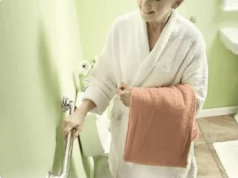We all love a good shower or bath. It washes away sweat, dirt, and stress, leaving us feeling refreshed and rejuvenated. But what if we told you that showering at the wrong time could put your life at risk ?
While bathing is a daily ritual for most, timing matters more than you think . There are certain moments when your body is in a vulnerable state — and jumping into the shower, especially with extreme water temperatures, can trigger dangerous shifts in blood pressure, circulation, and heart function. In worst-case scenarios, this can lead to dizziness, fainting, or even a stroke .
To help you stay safe, here are 5 times you should absolutely avoid showering — no matter how dirty or sweaty you feel.
1. Right After Eating a Full Meal
Why it’s dangerous:
After you eat, your body directs blood flow to the digestive system to break down food. If you hop into the shower immediately — especially with hot water — the heat causes blood vessels in your skin to dilate. This pulls blood away from your stomach and toward the surface of your skin, disrupting digestion and reducing blood supply to vital organs, including the brain.
This sudden shift can cause:
- Indigestion or bloating
- Dizziness or lightheadedness
- A spike or drop in blood pressure
- Increased risk of ischemic stroke in vulnerable individuals
✅ What to do instead:
Wait at least 30 minutes to 1 hour after eating before showering. This gives your body time to digest properly and stabilize circulation.
2. When You Have a High Fever
Why it’s dangerous:
When you’re running a fever, your body is already dehydrated and struggling to regulate its temperature. Taking a cold shower might seem like a quick fix, but it can cause sudden constriction of blood vessels , leading to:
- Chills and shivering
- Shock-like symptoms
- A dangerous drop in core temperature
- Risk of fainting or cardiac stress
Even hot showers can worsen overheating.
✅ What to do instead:
Use a warm, damp cloth to gently sponge your forehead, neck, and arms. This helps cool you down gradually without shocking your system. Once your fever breaks, a lukewarm shower is safe.
3. Immediately After Intense Exercise
Why it’s dangerous:
After a workout, your heart is pumping hard, your blood pressure is elevated, and your body is redistributing blood to cool down. A sudden cold shower — often seen as invigorating — can cause rapid vasoconstriction (narrowing of blood vessels), which may:
- Spike your blood pressure
- Reduce blood flow to the brain
- Trigger dizziness, nausea, or even loss of consciousness
Hot showers aren’t safe either — they can increase strain on the heart.
✅ What to do instead:
Rest for 15–30 minutes after exercising. Let your heart rate and breathing return to normal. Then, take a warm (not hot or cold) shower to relax your muscles safely.
4. Late at Night, Especially with Cold Water
Why it’s dangerous:
In the late hours, especially during colder seasons, your body temperature naturally begins to drop in preparation for sleep. A cold shower at night can exaggerate this drop, leading to:
- Sudden blood vessel constriction
- Increased blood pressure
- Higher risk of stroke or heart attack , particularly in older adults or those with cardiovascular conditions
Cold exposure at night may also weaken immunity temporarily, increasing susceptibility to colds and respiratory infections.
✅ What to do instead:
If you must shower at night, use warm water (37–40°C / 98–104°F) . Dry yourself thoroughly — especially your hair, head, and neck — to prevent chilling.
5. When Your Blood Pressure Is Unstable
Why it’s dangerous:
People with hypertension (high blood pressure) or hypotension (low blood pressure) are especially at risk. Sudden temperature changes during a shower can cause:
- A dangerous spike or plunge in blood pressure
- Headaches
- Blurred vision
- Fainting
- In extreme cases, hemorrhagic or ischemic stroke
Hot water dilates blood vessels, while cold water constricts them — both can be risky if your system is already unstable.
✅ What to do instead:
- Use lukewarm water — never extreme temperatures.
- Keep showers short (10–15 minutes).
- Sit down if you feel dizzy.
- Avoid locking the bathroom door in case of emergencies.
Safe Showering Tips for Optimal Health
To enjoy the benefits of bathing without the risks, follow these guidelines:
🌡️ Water Temperature:
Stick to 37–40°C (98–104°F) — warm, not scalding or icy.
⏱️ Duration:
Limit showers to 10–15 minutes to prevent dehydration and fatigue.
🧽 Dry Off Completely:
Especially your head, neck, and feet — dampness can lead to chills and joint pain.
🧘 Take It Slow:
Stand up slowly after showering to avoid sudden drops in blood pressure.
🩺 Listen to Your Body:
If you feel dizzy, weak, or unwell — skip the shower and rest.
Final Thoughts: Clean Doesn’t Have to Mean Risky
Showering is essential for hygiene and well-being — but timing and temperature are critical . Your body goes through natural shifts throughout the day, and ignoring these rhythms can have serious consequences.
By avoiding showers during these 5 high-risk times , you’re not just staying clean — you’re protecting your heart, brain, and overall health.
So next time you reach for the towel right after dinner or post-workout, pause and wait . Your body will thank you — and you might just prevent a life-threatening situation.










